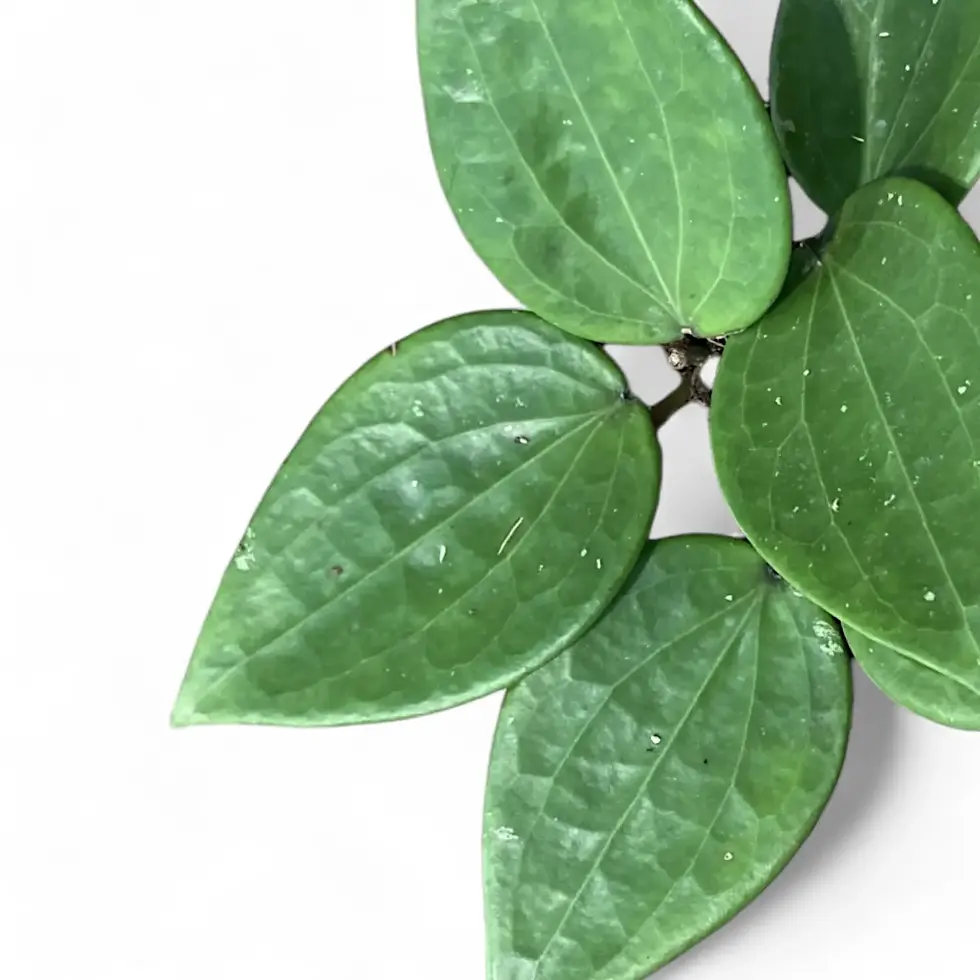Hoya latifolia - Exotic Greenery with Large, Glossy Leaves
Transform your indoor garden with the lush, tropical beauty of Hoya latifolia! Known for its thick, pancake-like leaves and clusters of fragrant flowers, this exotic climber thrives in bright indoor spaces. Native to Southeast Asia, Hoya latifolia is a low-maintenance yet visually striking houseplant. Its broad, rich green foliage, highlighted with delicate veins and reddish-purple edges, makes it an eye-catching addition to any home.
Distinct Features of Hoya latifolia
- Striking Foliage: Large, heart-shaped leaves (10-15 cm) with a glossy surface and light veins.
- Fragrant Blooms: Creamy-white, star-shaped flowers with yellow or orange centers and a sweet scent.
- Growth Habit: A natural climber that thrives when supported, perfect for trellises or hanging displays.
Natural Habitat and Growth Characteristics
- Origin: Found in the tropical forests of Indonesia, Thailand, and Myanmar.
- Climate: Thrives in consistently warm temperatures of 18-26°C with moderate to high humidity.
- Indoor Size: Grows up to 1.5 m in height with a spread of about 1 m.
- Growth Rate: A moderate grower, producing new leaves and vines primarily during the growing season.
- Toxicity: Mildly toxic to pets and humans if ingested — keep out of reach of children and animals.
- Lifecycle: A long-lived, evergreen perennial that maintains year-round vibrancy.
How to Care for Hoya latifolia
- Light: Prefers bright, indirect light. Avoid direct sun exposure to prevent leaf scorch.
- Watering: Allow the soil to dry between waterings. Use lukewarm water to prevent root shock.
- Humidity: Enjoys high humidity levels. Use a humidifier or group with other plants to maintain optimal conditions.
- Temperature: Best kept between 18-26°C. Protect from drafts and cold temperatures below 15°C.
- Soil: A well-draining mix with perlite, orchid bark, and coco coir ensures aeration and moisture balance.
- Repotting: Repot every 2-3 years. Use terracotta pots for better moisture control.
- Fertilizing: Apply a diluted liquid fertilizer every 3-4 weeks during active growth.
- Propagation: Easily propagated from stem cuttings. High humidity is essential for successful rooting.
- Hydroponics: Adapts well to semi-hydroponic setups for low-maintenance growth.
- Pruning: Trim leggy stems to encourage a fuller shape and remove damaged leaves regularly.
- Support Structures: A trellis or moss pole supports climbing growth and prevents tangling.
Common Problems with Hoya latifolia and Solutions
- Pests: Treat mealybugs with alcohol-dipped cotton swabs and use insecticidal soap for spider mites and fungus gnats.
- Root Rot: Symptoms include yellowing leaves and mushy roots. Repot with fresh, well-draining soil.
- Leaf Issues:
- Yellow Leaves: Overwatering or poor light conditions.
- Brown Tips: Indicates low humidity or inconsistent watering.
- Drooping Leaves: A sign of underwatering — adjust watering routine.
- Fungal Diseases: Avoid misting and improve air circulation to prevent leaf spot and mildew.
- Lack of Blooms: Provide stable care, bright indirect light, and regular feeding to encourage flowering.
Pro Tips for Thriving Hoya latifolia
- Clean leaves regularly with a damp cloth to enhance their glossy texture.
- Provide stable humidity and light conditions to mimic its natural habitat.
- Avoid frequent repotting to promote flowering.
Etymology and Botanical Background
Hoya: Named in honor of Thomas Hoy, an English botanist from the 18th century.
latifolia: Derived from Latin, meaning “broad-leafed,” referring to its large, thick foliage.
Frequently Asked Questions
- How can I get Hoya latifolia to flower?
Ensure bright, indirect light, consistent feeding, and avoid frequent repotting.
- Why are my Hoya latifolia leaves drooping?
This is often due to underwatering or low humidity. Adjust conditions for better hydration.
- How do I maintain glossy leaves?
Wipe leaves gently with a damp cloth to remove dust and enhance their shine.
- What is the best pot for Hoya latifolia?
Pots with drainage holes are essential. Terracotta is ideal for moisture regulation.
Bring Tropical Elegance to Your Home - Order Hoya latifolia Today!
Enhance your indoor space with the vibrant beauty and easy care of Hoya latifolia. Shop now and enjoy the exotic charm of this stunning houseplant!
Hoya latifolia
Hoya latifolia is approximately 15 cm tall and comes in a ⌀ 12 cm pot.


























